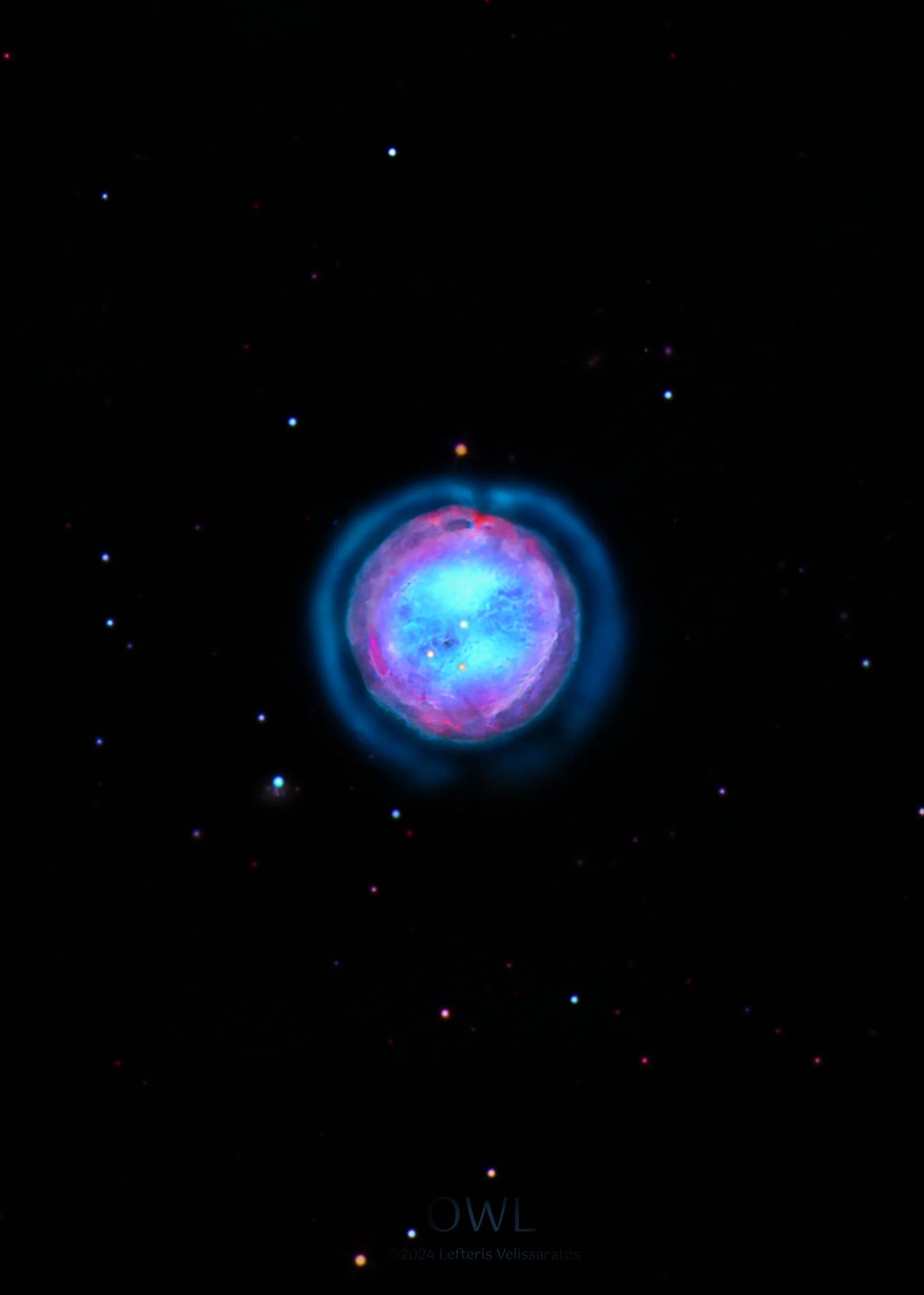
AAPOD2 Image Archives
The OWL Nebula
Drifting in the constellation Ursa Major, Messier 97 (M97), commonly known as the Owl Nebula, is one of the most well-defined planetary nebulae in the night sky. Located approximately 2,000 light-years away, this cosmic apparition represents the final stages of a dying Sun-like star, shedding its outer layers into space and leaving behind a hot, compact white dwarf at its core.
The Owl Nebula spans about 3 light-years across, with an intricate shell of glowing gas expanding outward at roughly 40 km/s. In this HaLRGB image, the deep hydrogen-alpha (Hα) emissions reveal the nebula’s faint outer structures, while the luminous oxygen (OIII) and sulfur (SII) emissions add layers of complexity, painting a vivid portrait of this celestial ghost.
Its famous “owl-like” appearance arises from two large, dark voids in its inner shell, thought to be the result of complex stellar winds and asymmetric ejections of material. The nebula’s core, a blazing white dwarf with a temperature exceeding 100,000 K, continues to ionize the surrounding gas, causing it to glow for thousands of years before fading into the depths of interstellar space.
Captured in exquisite detail, this image showcases the haunting beauty of M97, a celestial owl whose watchful gaze reminds us of the delicate yet powerful forces governing the life and death of stars.
The OWL Extended Version
The Owl Nebula, also known as Messier 97 (M97), is a captivating planetary nebula located in the constellation Ursa Major, approximately 2,030 light-years from Earth. Named for its resemblance to an owl's face, with two dark circular features resembling eyes, M97 is one of the more complex and studied planetary nebulae. This nebula represents the final stages of a star similar in mass to our Sun, which has expelled its outer layers, leaving behind a hot, dense white dwarf at its center.
M97 spans about 3.4 light-years in diameter and is notable for its intricate structure and varying emission lines, which provide insights into the composition and dynamics of the ejected material. The "eyes" of the Owl Nebula are believed to be regions with less dense gas, allowing us to see deeper into the nebula. Observations in various wavelengths, including optical and infrared, have revealed details about the chemical abundances and physical conditions within M97, offering valuable clues about the processes involved in the late evolutionary stages of stars.
The owl nebula - m97
The Owl Nebula, also known as Messier 97 (M97, NGC 3587, PN G 148.4+57.0), is a planetary nebula located in Ursa Major.
L-channel - 20 x 300 sec. bin 1x1;R-channel - 14 x 600 sec. bin 1x1;G-channel - 14 x 600 sec. bin 1x1;B-channel - 14 x 600 sec. bin 1x1;OIII- 40 x 900 sec. bin 2x2.Total integration time about 18:40 hours.
My setup: Telescope 8" Celestron Schmidt-Cassegrain (SCT) CPC800 GPS (XLT) on the equatorial wedge, focal reducer Starizona 0.75x, Feq.= 1626mm, camera Starlight Xpress Trius SX694, SX mini filter wheel, filters Astrodon LRGB E-series gen.2, Astrodon OIII 3nm.Capture and processing software: MaxIm DL6, PHD2, PixInsight, StarTools, Photoshop CC, Zoner photo studio 14.North at the top.
Copyright: Boris Vladimirovich




